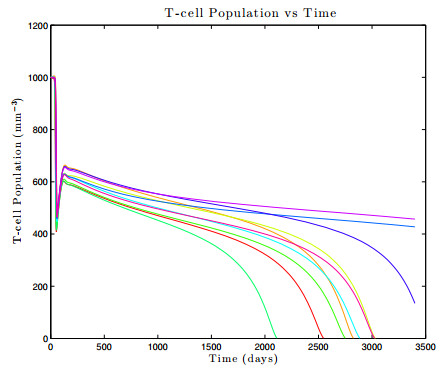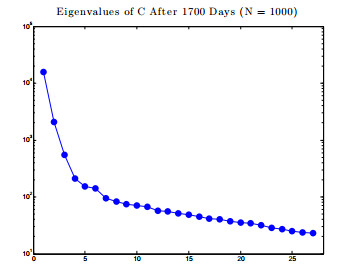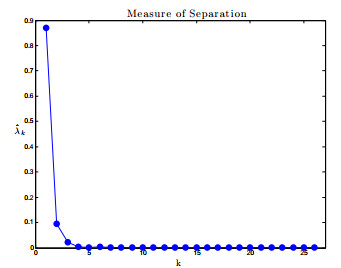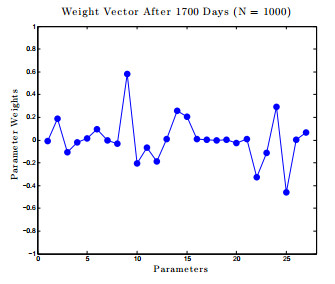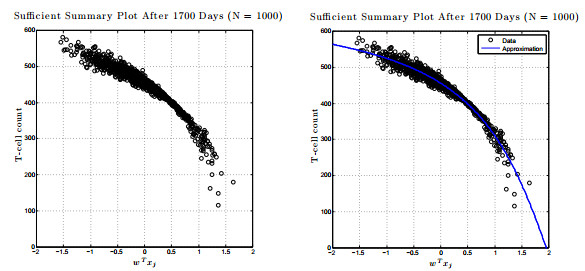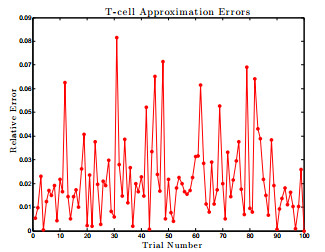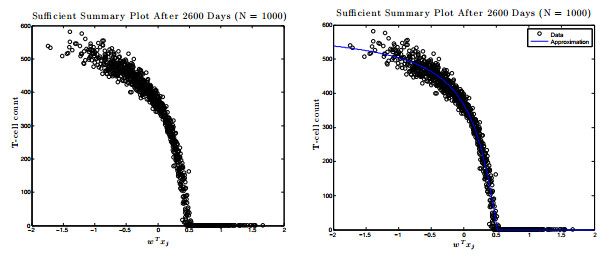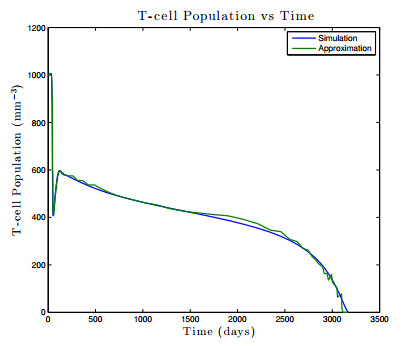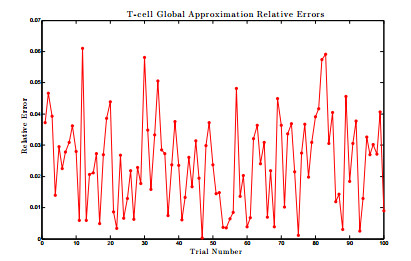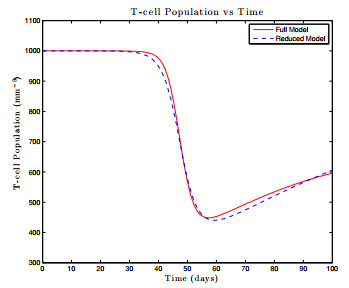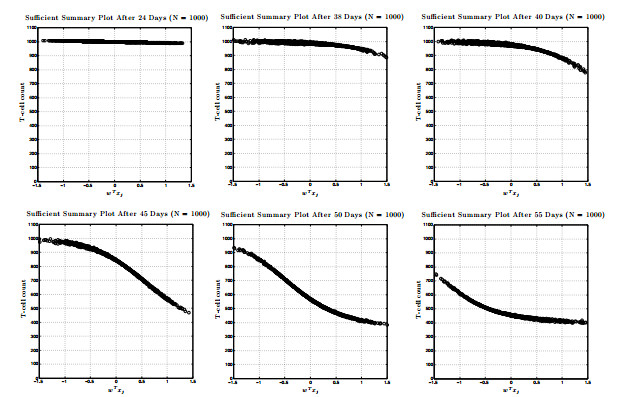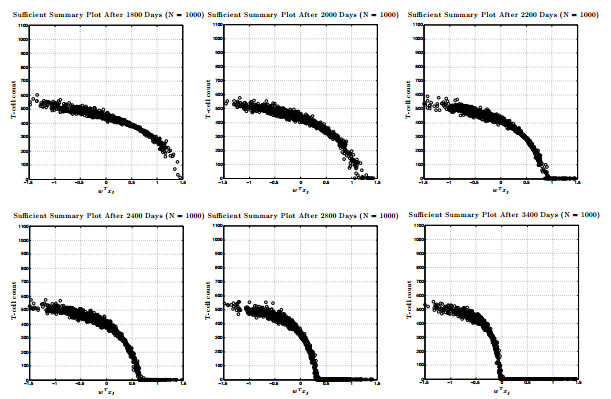Recently, a long-term model of HIV infection dynamics [
8] was developed to describe the entire time course of the disease. It consists of a large system of ODEs with many parameters, and is expensive to simulate. In the current paper, this model is analyzed by determining all infection-free steady states and studying the local stability properties of the unique biologically-relevant equilibrium. Active subspace methods are then used to perform a global sensitivity analysis and study the dependence of an infected individual's T-cell count on the parameter space. Building on these results, a global-in-time approximation of the T-cell count is created by constructing dynamic active subspaces and reduced order models are generated, thereby allowing for inexpensive computation.
1.
Introduction
V. cholera is a gram-negative, facultative, motile anaerobe that secrets a diarrhoeagenic protein called cholera toxin [1]. The organism has over 200 serogroups, but only the O1 and O139 serogroups have been linked to the diarrheal disease commonly known as cholera [2]. In third world countries, the organism typically transmits by drinking contaminated surface water [3], whereas, in developed countries, transmissions are associated with raw or undercooked shellfish consumption [4]. Cholera is a frequent occurrence in Bangladesh, with seasonal outbreaks occurring annually [5]. Since V. cholera is predominantly an aquatic organism, the propagation and epidemiology of these outbreaks are highly influenced by contaminated water sources and flooding. In most rural areas of Bangladesh, access to potable clean drinking water is minimal, especially during annual flooding. A vast majority of the population still drinks untreated surface water in rural areas of the country and most of these annual outbreak buds in those populations.
Furthermore, underground water sources like tube wells are often submerged and contaminated by flood water during annual flooding. Thus, it is crucial to perform a comparative study of V. cholera contamination among different surface and underground water sources as a part of consistent surveillance operation. Besides, annual cholera outbreaks are often treated with the same group of antibiotics, resulting in a high antibiotic resistance in V. cholera strains against commonly used antibiotics. A yearly evaluation of the antibiotic resistance profile of field strains is necessary for the effective therapeutic use of available antibiotics. Therefore, this research aimed at quantifying V. spp. in different water sources of Bangladesh and evaluating the antibiotic resistance profile of V. cholera to estimate and mitigate the risk of the annual cholera outbreak.
2.
Materials and methods
2.1. Sample collection, bacteria isolation, and quantification
A total of 45 environmental water samples were aseptically collected from pond, river and tube-well of different designated areas of Gazipur district, Bangladesh (Benupur, Chandabaha, Kaliakoir, Sutrapur and Begunbari). Following collection 4 samples are then serially diluted in alkaline peptone water and streak on selective media of Thiosulfate Citrate Bile Salts Sucrose (TCBS) agar, (Hi media, India) and incubated 37 °C for 24 hours. Following incubation, colonies with shiny yellow color and smooth, convex, and slightly flattened texture with opaque centers (Figure 1A, 1B) were used in viable count of V. spp. [6]. For bacteria isolation 1 mL of buffer peptone solution (1:10 dilution) was enriched in nutrient broth at 37 °C for 16 hours and then transferred in selective media (TCBS agar plate) for incubation (37 °C for 24 hours). Then one colony was randomly selected from each plate for biochemical analysis and hemolysis test (Figure 1C, 1D).
2.2. Biochemical test
V. spp. isolated in selective media were confirmed as V. cholera by different biochemical tests Catalase, Oxidase, MR, VP, Indole, glucose, maltose, mannitol and sucrose fermentation) according to the methodology described in [7].
2.3. Antibiotic susceptibility test
Antibiotic sensitivity test was performed according to Kriby-Bauer disc diffusion method [9] and following the guideline of Clinical and Laboratory Standards Institute [8]. A total of 11 commercially available antibiotics were used (Table 1) in this research to assess drug susceptibility and resistance of isolated species (Mast diagnostics Mersey side, UK). A single colony of pure culture isolated from the samples was incubated in nutrient broth at 37 °C for 16 hours. Then 0.1 ml of broth was spread on Mueller-Hinton agar plate using a cell spreader and an antibiotic disc was placed on top. The plates were then incubated in 37 °C for 24 hours. After incubation, the zone of inhibition near the discs was measured using a millimeter scale and categorized as resistant or sensitive according to the manufacturer's recommendation (Table 1).
2.4. Statistical analysis
A total of 5 replicate samples were randomly collected from each of the 5 different locations (Benupur, Chandabaha, Kaliakoir, Sutrapur, Begunbari) of each 3 water sources (river, pond and tube-well). Bacterial concentration in samples were log transformed and subjected to Shapiro-Wilk test for normality analysis. Bartlett's Test was performed to ensure the homogeneity of variance among the collected samples. The bacterial concentration in different water sources and at different locations were analyzed with one-way ANOVA using the GLM procedure of SAS software (version 9.2) under the following model. Yij = µ + Ti + δL + ϵij. Where, Yij = Bacterial concentration in each sample; µ = Overall mean bacterial concentration; Ti = Effect of water source; δL = Blocking effect of location and ϵij = random error. We assumed that the variation within the model, caused by from sampling location are normally distributed with a mean of 0 and a variance of σL2. Random error ϵij of the model is also normally distributed with a mean of 0 and a variance of σ2. Both variances σL2 and σ2 are independent of each other. For data analysis, P < 0.05 was considered statistically significant and when a significant difference is detected, the were subjected to the least significant difference test (LSD) for mean separation.
3.
Results and discussion
Viable counts were performed on TCBS agar plate which selects V. spp. based on their sucrose fermentation characteristics and the result is presented in Table 2. There was significantly higher V. spp. in pond and river water than tube-well water (P < 0.001) at all 3 dilution levels (dilution factor: 103, 104 and 105). Bacterial concentration did not vary significantly based on the location of sample collection (P > 0.05) (Table 3).
Total of 14 biochemical tests were performed on isolates of different samples and the result of those tests are presented in Table 4. Out of the 30 isolates, 12 isolates were positive in nitrate, oxidase, indole, citrate utilization, MR, motility, glucose, sucrose, mannitol, maltose, and gelatin hydrolysis agar test (Figure 2A, 2F). V. spp. were also found to be negative in MR, urease, and kingler iron agar test. Hemolytic characteristics of the isolates were also evaluated to differentiate between V. cholera and V. parahaemolyticus (Figure 1C, 1D). V. cholera are known to cause β-hemolysis whereas V. parahaemolyticus causes α-hemolysis. Based on this characteristic 12 of the initial isolates were classified as V. cholera and remaining 18 was classified as V. parahaemolyticus.
The comparative prevalence of V. cholera among the V. spp. isolated from different water sources are presented in Table 5. River water had the highest prevalence of V. cholera (5 out of 12 isolates; 41.67%) whereas, tube-well water had the lowest prevalence (3 out of 8; 37.5%).
The results of antibiotic sensitivity test performed on 12 V. cholera isolates are presented in Table 6. The antibiotic sensitivity profiles of those isolates have been compiled in Table 7. All 12 isolates showed 100% sensitivity toward Gentamicin and ciprofloxacin. All the isolates showed multidrug resistance (Table 6). However, these isolates were susceptible to Chloramphenicol (91.67%), and Sulfamethoxazole (91.67%). Azithromycin (66.67%). Tetracycline (33.33%), and Cephalexin (16.67%) had moderate to low sensitivity. All 12 isolates showed 100% resistance toward Penicillin, Vancomycin, Erythromycin, and Nalidixic Acid. This result is congruent with the study of [10] performed in neighboring country Nepal, where they found their isolates sensitive to Ciprofloxacin, Ampicillin, and resistant to Nalidixic acid. However, unlike this study, their isolates also showed higher sensitivity toward Erythromycin and Tetracycline. The majority of resistance in environmental species are thought to have originated from historically resistant organisms. As a result, it's essential to keep track of both the frequency and the antimicrobial resistance profile of V. cholera to identify the high-risk water sources. To minimize the risk of cholera transmission through contaminated water, we recommend screening various water sources against this pathogenic bacteria before using it for washing, drinking and irrigation. Vulnerable populations, especially farmers in rural areas, should take appropriate precautions to avoid cholera transmission through water [11]. There were some limitations to our research. Due to the funding constrain, a limited number of samples were collected, which might not be sufficient to draw a precise conclusion. Our analysis still lacks molecular characterization of the isolates, which might have strengthened our conclusion.
4.
Conclusion
Based on the data of our experiment we conclude that V. cholera is endemic to the surface water sources like pond and river in Gazipur region of Bangladesh. Underground water like tube well has comparatively lower concentration of V. cholera Antibiotics like, Gentamicin, Ciprofloxacin, Chloramphenicol, Sulfamethoxazole and Azithromycin are highly effective against the V. cholera isolates collected in this study. We suggest the application of these antibiotics in therapeutics of annual cholera outbreak. Furthermore, we highly recommend prioritizing underground water over surface water as drinking water source.









 DownLoad:
DownLoad:



